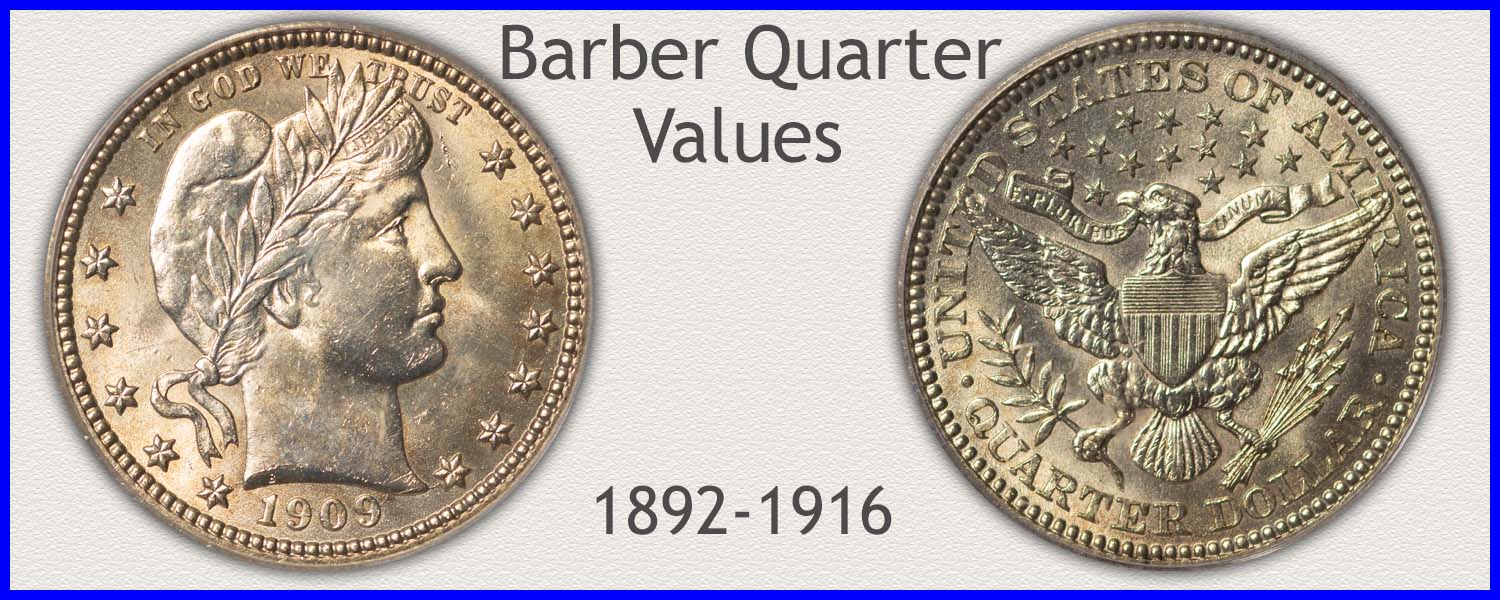Coin Values Moving with Precious Metals: Up-Dated 4/14/2025: Gold $3226 | Silver $31.88
1909 Quarter Value
Mintmarks are identified and collectible 1909 quarter value is narrowed using a step-by-step approach.
In 1909, four mints produced quarters, each with a different availability today. First step is to identify the various mintmarks using a series of images. The next step is to examine your coin alongside images representing varying degrees of wear.
When determining how much these quarters are worth, condition plays a significant role. By following the method shown below, find and gather the key information required to make an informed decision.
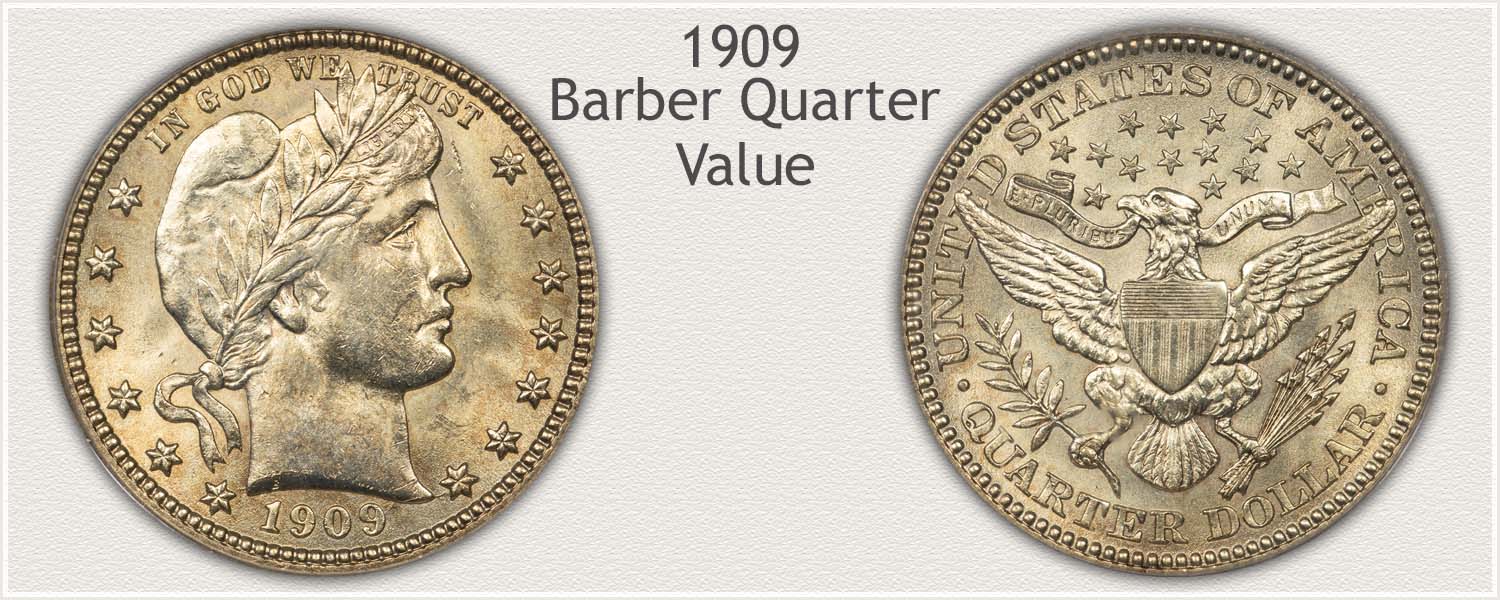
Steps Leading to Value:
- Step 1: Date and Mintmark Variety - Identify the specific 1909 quarter variety among the four different mints that struck these coins.
- Step 2: Grading Condition - A coin's condition and grade vary according to the degree of wear and its general appearance. Grading is essential in confirming the value of a coin.
- Step 3: Special Qualities - New Orleans mint ended production of quarters in 1909. These coins are a popular subset of the series and present a few challenges to collectors.
| 1909 Quarter Value | ||||
|---|---|---|---|---|
| Condition of Coin | ||||
| Date | Good | Fine | Extremely Fine | Mint State |
| Barber Quarter Values Updated | 4/14/2025 | |||
| 1909 | $7.69 | $15 | $56 | $245 |
| 1909 D | $7.69 | $16 | $54 | $256 |
| 1909 O | $49 | $369 | $1,968 | $2,947 |
| 1909 S | $8.86 | $32 | $108 | Rare |
Use the chart to determine a range of wholesale values, what a dealer pays for these old Barber quarters.
Step 1: | Date and Mintmark - Four Different Varieties
Three Abundant Varieties and One Scarce Issues to Recognize
1909 quarters were produced at four mints with the combined yearly total large enough to supply commerce. Collectors today seek an example from each mint as part of a complete set of Barber quarters. Branch mints were required to identify their production with a mintmark.
Notable for the year is the low number of quarters struck by the New Orleans mint. Identify the exact mint variety to accurate value.
1909-S Barber Quarter
"S" Mintmark on Reverse: San Francisco Mint Struck the Coin
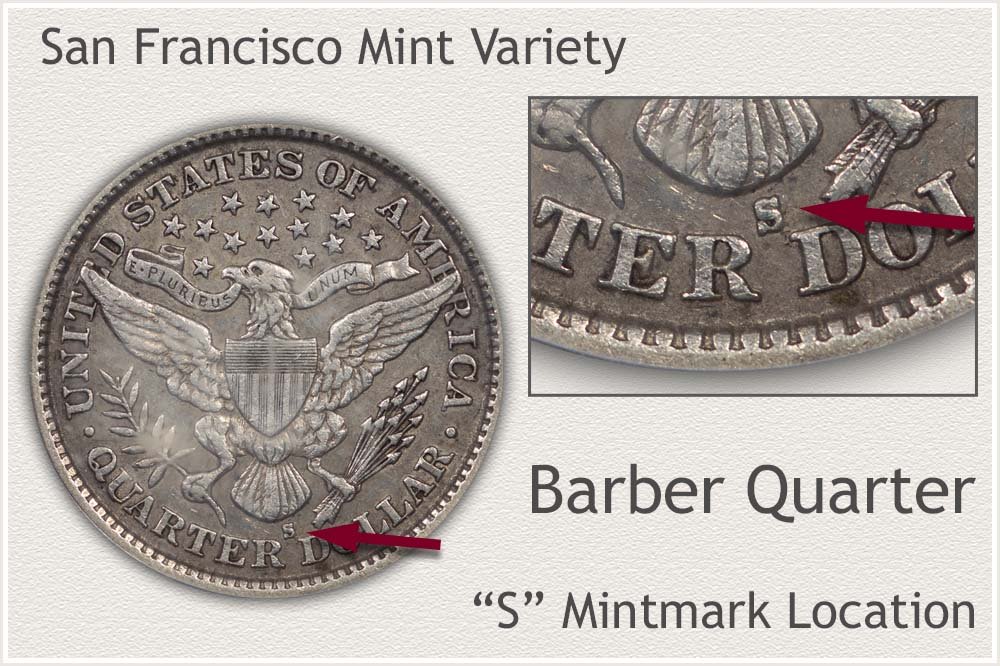
Popular mint varieties of the Barber series include the 1909 San Francisco quarter. Collectors recognize the mint issue's overall scarcity, which is reflected in the chart's premium value. Only 1,348,000 coins were issued into circulation, a low number when compared to other mints' production. Coins struck in the early twentieth century are now considered historical and important.
Scarcity of this issue in high condition is an important consideration to collectors. On the chart, strong values are shown for the very few examples that are still available with aesthetically pleasing detail.
The United States has a branch minting facility located in San Francisco. To distinguish its coins during the Barber series, the mint used a "S" mintmark. Look for the letter "S" below the eagle's tail feathers on the coin's reverse.
1909-O Barber Quarter
"O" Mintmark on Reverse: New Orleans Mint Struck the Coin
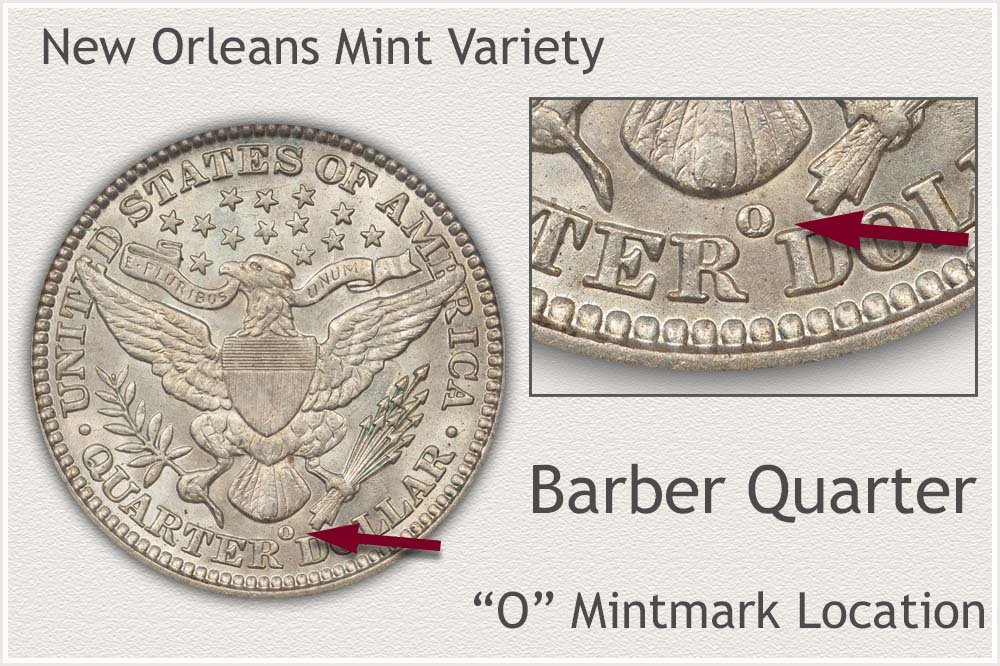
New Orleans quarters of 1909 represent the last of coinage from the mint. Beginning operations in 1838, New Orleans struck only silver and gold coins throughout the years. Their production of quarters in 1909 was limited to just 712,000 pieces, lowest of the New Orleans issues of the Barber series.
These are one of the higher demand coins in the series featuring a low mintage and popular obsolete mint variety. An elusive coin in nice eye-appealing condition.
The New Orleans mint placed an "O" mintmark on all quarters they struck. These marks are on the reverse in the area just below the tail feathers of the eagle. Confirming the "O" mintmark on a 1909 quarter finds a highly collectible coin.
1909-D Barber Quarter
"D" Mintmark on Reverse: Denver Mint Struck the Coin
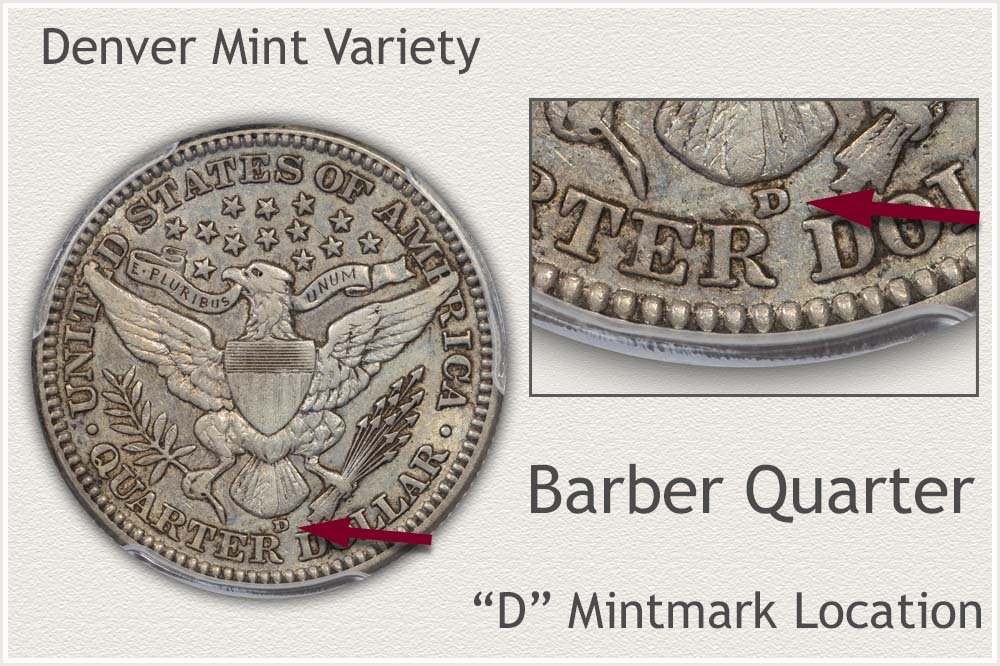
1909 was a year the Denver mint's production again exceeded five million quarters. Mint records show a total of 5,117,000 released into circulation. With ample quantities struck, these are considered available today in average worn condition. A steady demand for the coin is its silver content and finds a strong support in the silver market. Collectors specifically are in search of examples in high levels of condition as seen by the values represented on the chart.
Identifying the Denver issues is the "D" mintmark found on the reverse. All branch mints of the U.S. use mintmarks on their coinage. Each date/mint combination is collected and valued separately.
Turning to the reverse, look above and to the right of the ending "R" of "QUARTER". This large "D" is Denver's mintmark, confirming the mint issue.
1909 Barber Quarter
No Mintmark on Reverse: Philadelphia Mint Struck the Coin
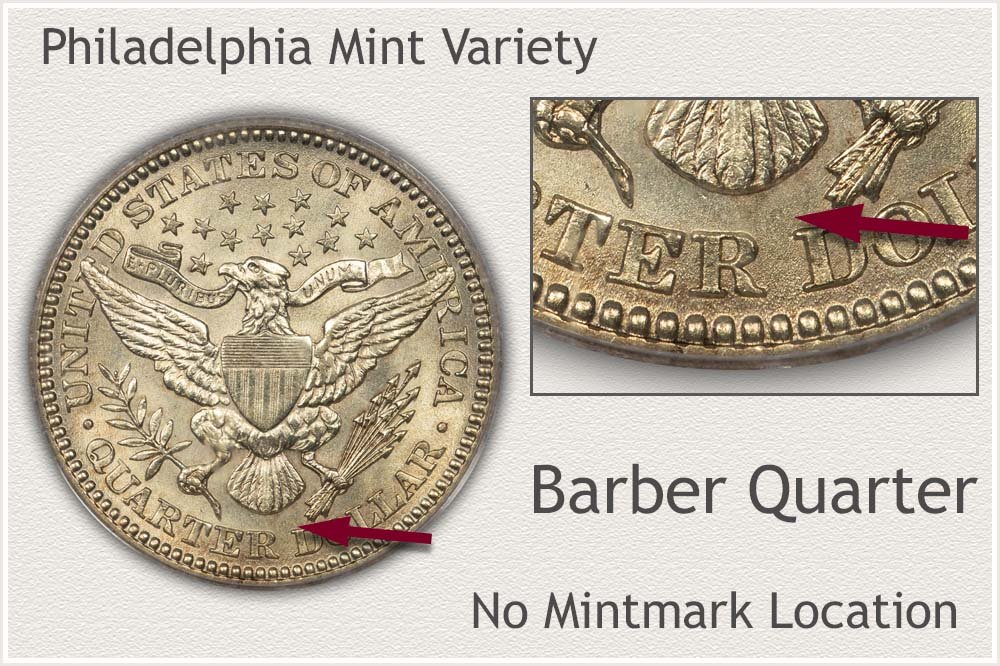
1909 was an active year at the Philadelphia mint. Striking just over 9.2 million quarters. When viewing the chart, these are valued very close to their underlying silver value. This is however a starting value; condition next plays a role.
Demand by collectors for coins in the Barber series helps to support the premiums placed on those in pleasing condition. Examples found heavily worn are considered common and typically valued at or just above their silver content.
During the Barber series, mintmarks were used by the branch U.S. mints. Philadelphia, the main mint, did not put a mark on its coinage. Barber quarters are identified by both date and mint. If a blank space is visible above the "R" and "D" of Quarter Dollar on the reverse, this confirms the Philadelphia variety.
Step 2: | Grading Judges and Separates Low to High Quality
Identify Condition and 1909 Quarter Value
There is small, but important, differences between each grade. These old quarters become more valuable as they display finer details of their design.
Grading sorts the different stages of wear into defined categories. Comparisons to standards determine a grade's narrow condition range.
Mint State Grade
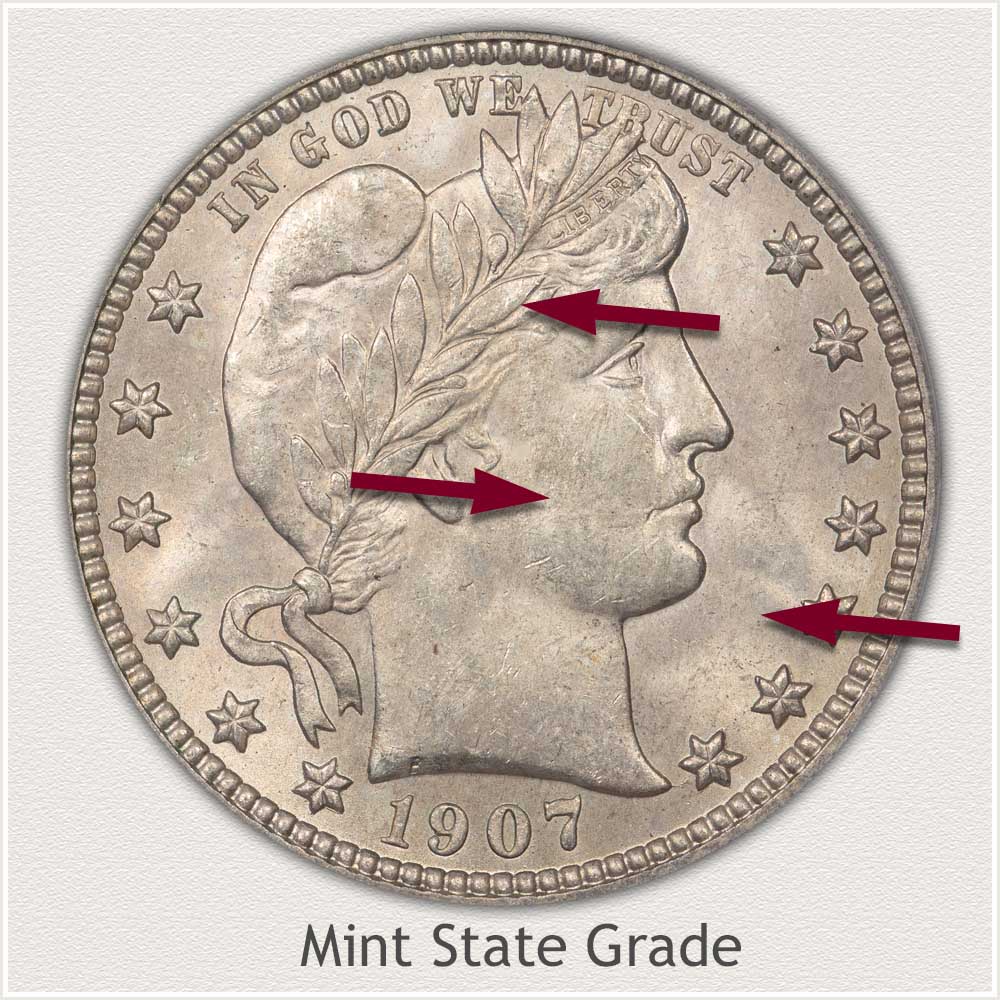
Mint State: Mint State grade is defined by a coin's complete lack of wear that removes its luster. Such coins were never used in commerce, did not circulate and receive wear to the surface. A Barber quarter that has not been worn retains the high points of the design with their original luster.
Examine Liberty's cheek and how the surface texture is consistent both on the raised and lower portions of the contour. Both the high and low points are covered in luster.
Additionally, there is no sign of flattening of the leaf edges due to wear and metal removal on the wreath within Liberty's hair.
Without wear, a full luster spreads across the coin's surface when tilted and rotated under a light.
Extremely Fine Grade
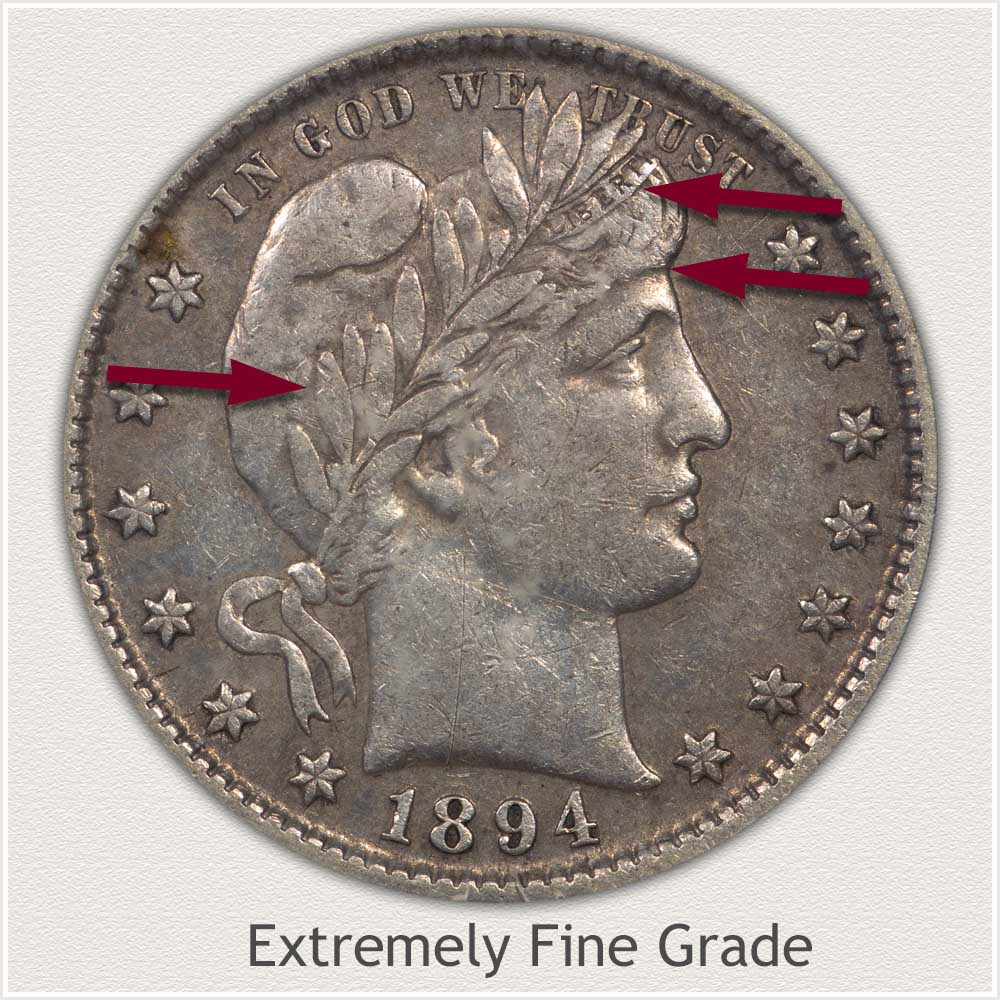
Extremely Fine: A grade of "Extremely Fine" refers to the condition of a quarter that exhibits only a small amount of clearly visible wear. Within the Barber series, these coins in excellent condition, are highly collectible, and sought by numerous collectors. A subtle silver-grey tone to the metal has taken the place of the original mint shine.
Liberty's hair, specifically the area right above her forehead, shows signs of early wear. A small amount of blending has flattened most of the fine strands of hair in the design. Look at both the bottom and top edges of the headband in the area. A clear band, separate from the hair, places this coin within the grade.
All of the leaves in the wreath are sharply outlined with very distinct leaf contours, becoming an important aspect of the grade. Only the edges of the leaves show any slight wear. First impression of the coin is one of sharp detail. Lacking noticeable blemishes, the coin is a nice example of the grade Extremely Fine.
Fine Grade
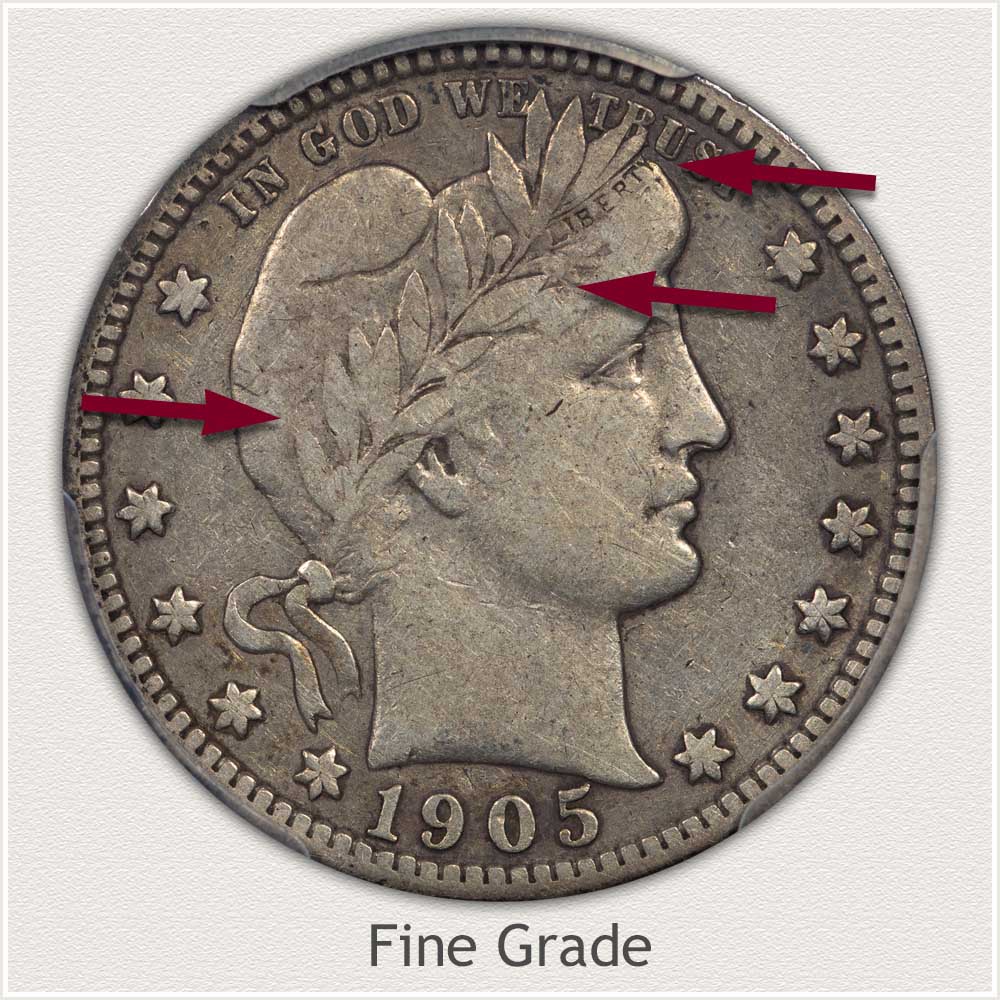
Fine Grade: Often difficult to locate is a nicely detailed Barber quarter. Overall condition of this collectable is somewhat worn with a few flattened areas. A quarter receives a Fine grade if the majority of the detail is visible and there are no large flat spots.
The laurel wreath in Liberty's hair is one feature of particular interest. This wreath extending to the forehead, bound by a ribbon and knot at the end, must have strong outlines of the upper row of leaves. The leaves are now completely smooth and flat from wear, but distinct, confirming the Fine grade and only moderate wear. However, Liberty's hair is merging with the edges of the lower row of leaves. A feature that indicates moderate wear while keeping the condition in the Fine range is the different amount of wear to upper and lower leaves.
Even though these coins show wear and flattening to the surface, they are within the collector quality range. Examples appealing to collectors are coins displaying an original silver-grey color with deeper tones highlighting the devices.
Good Grade
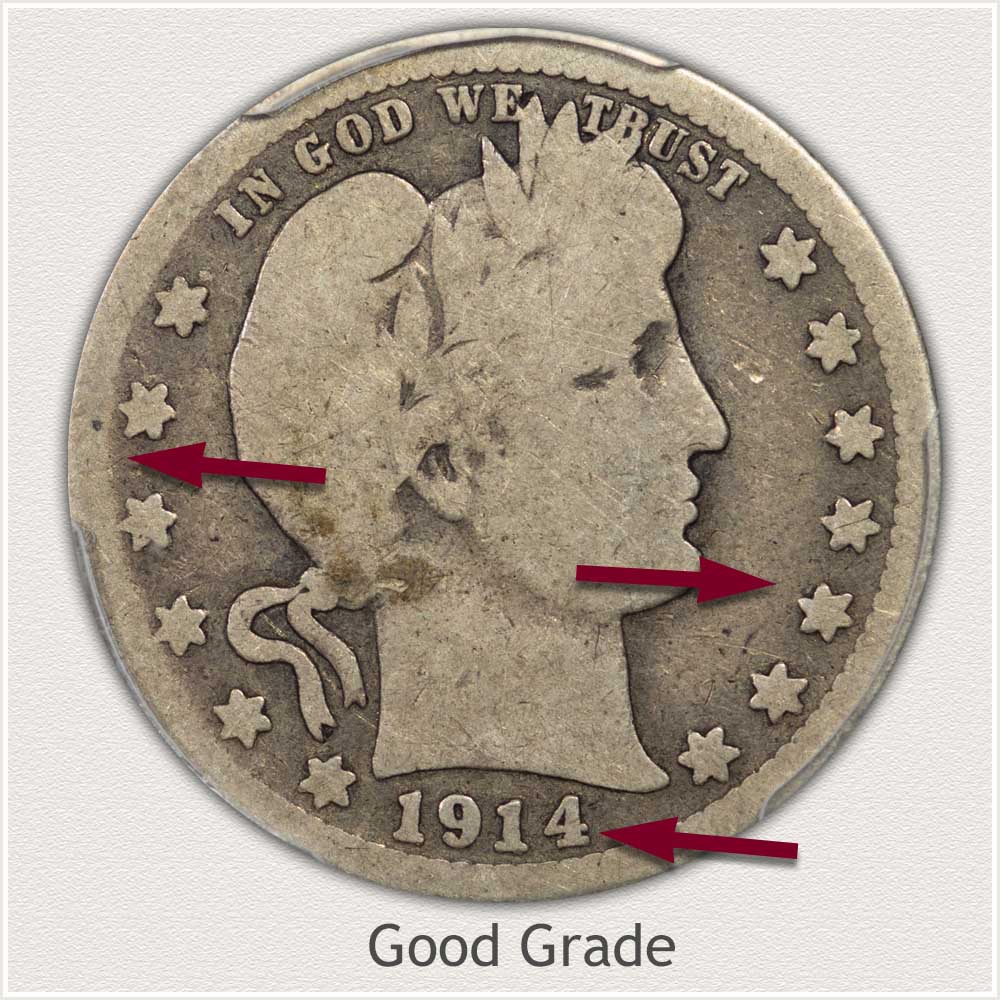
Good Grade: Good grade defines the condition of a quarter in which all major design elements are worn smooth but are still well raised above the fields of the coin.
All of the digits in the date, for example, are bold and complete. Their boldness is not fading or merging with the rim. In regards to the rim itself, it is well worn and greatly reduced from its original height. The inner edge to the rim is examined and remains intact all the way around the coin.
All of the stars in the design are completely outlined. These stars and the lettering of the motto both remain very clear, giving the coin an overall crisp appearance. This example is a nice old quarter that has avoided any major marks or damage.
How to Video: Grading Barber Quarters
Review the video and examine the additional images carefully to determine how well these vintage quarters are preserved. Limit the chart's range of values.
Video, Images and Descriptions | Grading Barber Quarters
Step 3: | Special Qualities Enhancing Value
Ending of an Important Collectible Mint Variety
The New Orleans mint was one of four mints producing Barber quarters during the span of the series. As part of the coin hobby, collections are built around and often include an example of each different date and mint variety of a series. An ending to any of the mint varieties is quickly noticed drawing interest and close examination of its involvement in the series.
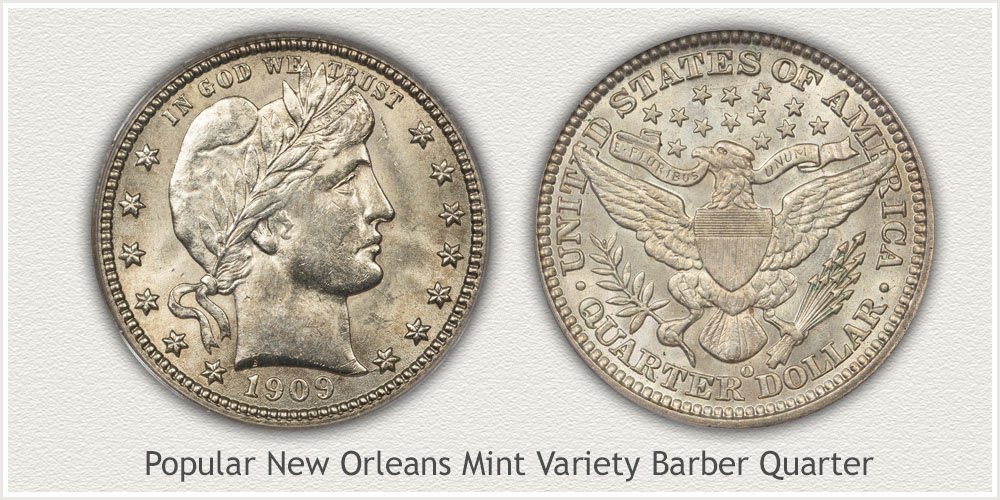
New Orleans is one of the mints introducing the Barber series in 1892. Until its final year of production in 1909, the mint contributed a steady input, striking on average 2 to 3 million quarters per year.
Because of its historical importance in U.S. coinage and now an obsolete mint operation, specialized collections of New Orleans quarters are a popular theme collection. Additional demand is placed on any nice example found.
Values of the 18 different years of New Orleans Barber quarters are similar with one large exception. With the closing year 1909; quarter were struck in the lowest numbers of the series, only 712,000 produced. 1909 is both the ending year and a record low production year.
Condition scarcity is an underlying base to strong values. It is also noted on the value chart the quick rise among examples in a higher state of preservation. An active economy in Louisiana, and its important transportation hub, few coins were idle or saved.
All New Orleans issues enjoy the special qualities of popular demand, historical significance of a discontinued mint facility, and scarcity in collector quality.
References
U.S. Mint. 1909 U.S. Mint Annual Report
https://nnp.wustl.edu/library/book/322
U.S. Mint. 1910 U.S. Mint Annual Report
https://nnp.wustl.edu/library/book/512058
U.S. Mint. 1911 U.S. Mint Annual Report
https://nnp.wustl.edu/library/book/323
Coin Values | CoinStudy Articles
Date by Date
In Depth Barber Quarter Values
1892 to 1916
Barber Quarter Value | Many In Demand Dates
Different condition coins are valued separately, also the many dates and mints of the Barber quarters range from common to scarce to very rare. Complete value chart of all dates and mints with condition ranges are listed. All dates of the series are in demand.
Quickly identify the many different U.S. coinage series. Refer to the chart listing starting values and linking to complete coverage of your coin. Images are used in a step-by-step process to accurately determine worth.
Print the Coin Values Worksheet
Organize Barber quarters on the worksheet by dates and mints along with condition and values. Record your entire group of old coins in one reference place.
Coin Grading Services | Authenticate and Grade of Coins
High value coins are routinely sent to a grading service to authenticate and grade the piece. The two leaders in coin grading are NGC and PCGS. Each provide assurance of condition and grade of coins helping narrow the value range. Market acceptance of condition is often worth the fee to review the coin.
★Coin Values Discovery finds 1909 Quarter Value and...
All old U.S. coin values. The home page Introduces the important steps in the value process. Identifying your coin series, accurate date and mint, and images to compare when judging condition. Key elements are noted to narrow a range of how much these old coins are worth.
